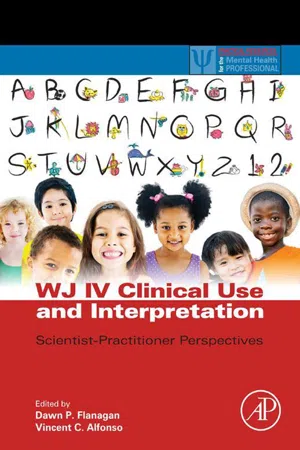
WJ IV Clinical Use and Interpretation
Scientist-Practitioner Perspectives
- 434 pages
- English
- ePUB (mobile friendly)
- Available on iOS & Android
WJ IV Clinical Use and Interpretation
Scientist-Practitioner Perspectives
About this book
WJ IV Clinical Use and Interpretation: Scientist-Practitioner Perspectives provides clinical use and interpretive information for clinical practitioners using the Woodcock-Johnson, Fourth Edition (WJ IV). The book discusses how the cognitive, achievement, and oral language batteries are organized, a description of their specific content, a brief review of their psychometric properties, and best practices in interpreting scores on the WJ IV.Coverage includes the predictive validity of its lower order factors and the clinical information that can be derived from its 60 individual subtests. Part II of this book describes the clinical and diagnostic utility of the WJ IV with young children for diagnosing learning disabilities in both school age and adult populations, and for identifying gifted and talented individuals.Additionally, the book discusses the use of the WJ IV with individuals whose culture and language backgrounds differ from those who are native English speakers and who were born and raised in mainstream US culture.- Discusses the organization and content of all three batteries in the WJ-IV- Reviews best practices for score interpretation- Covers psychometric properties and predictive validity- Explores clinical information that can be extracted from 60 individual subtests- Includes diagnostic utility for learning disabilities, giftedness, and non-English speaking populations
Frequently asked questions
- Essential is ideal for learners and professionals who enjoy exploring a wide range of subjects. Access the Essential Library with 800,000+ trusted titles and best-sellers across business, personal growth, and the humanities. Includes unlimited reading time and Standard Read Aloud voice.
- Complete: Perfect for advanced learners and researchers needing full, unrestricted access. Unlock 1.4M+ books across hundreds of subjects, including academic and specialized titles. The Complete Plan also includes advanced features like Premium Read Aloud and Research Assistant.
Please note we cannot support devices running on iOS 13 and Android 7 or earlier. Learn more about using the app.
Information
Overview of the Woodcock-Johnson IV
Organization, Content, and Psychometric Properties
Abstract
Keywords
Theoretical Underpinnings of the WJ IV
Table of contents
- Cover image
- Title page
- Table of Contents
- Copyright
- List of Contributors
- Preface
- Chapter 1. Overview of the Woodcock-Johnson IV: Organization, Content, and Psychometric Properties
- Chapter 2. Clinical Interpretation of the Woodcock–Johnson IV Tests of Cognitive Abilities, Academic Achievement, and Oral Language
- Chapter 3. A Special Validity Study of the Woodcock–Johnson IV: Acting on Evidence for Specific Abilities
- Chapter 4. Woodcock–Johnson IV Scoring and Reporting Online Program Review
- Chapter 5. Instructional Implications from the Woodcock–Johnson IV Tests of Cognitive Abilities
- Chapter 6. Instructional Implications from the Woodcock–Johnson IV Tests of Achievement
- Chapter 7. Strengths and Weaknesses of the Woodcock–Johnson IV Tests of Cognitive Abilities: Best Practice from a Scientist–Practitioner Perspective
- Chapter 8. Use of the Woodcock–Johnson IV in the Identification of Specific Learning Disabilities in School-age Children
- Chapter 9. Use of the Woodcock–Johnson IV in the Diagnosis of Specific Learning Disabilities in Adulthood
- Chapter 10. Use of the Woodcock–Johnson IV Tests of Cognitive Abilities in the Diagnosis of Intellectual Disability
- Chapter 11. Use of the Woodcock–Johnson IV Tests of Cognitive Abilities and Achievement in the Assessment for Giftedness
- Chapter 12. Assessment of Culturally and Linguistically Diverse Individuals with the Woodcock–Johnson IV
- Chapter 13. Neurocognitive Applications of the Woodcock–Johnson IV
- Chapter 14. Use of the Woodcock–Johnson IV in a Response to Intervention Service Delivery Model
- Index